Archives
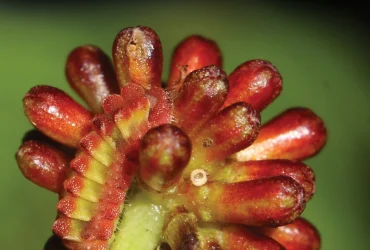 v6i2.140
v6i2.140ISSN: 1800-427X (print)
eISSN: 1800-427X (online)
DOI:10.47605/tapro.v6i2.140
Submitted date: 12 March 2013
Accepted date: 18 March 2014
Published date: 30 August 2014
Pp. 83–89, pls. 4–6.
TEMPORAL DIOECISM, MELITTOPHILY AND ANEMOCHORY OF Wendlandia glabrata (RUBIACEAE)
A.J. Solomon Raju & K. Venkata Ramana
*Corresponding author. E-mail: ajsraju@yahoo.com
Abstract
Wendlandia glabrata is a massive bloomer during February–March. Floral characteristics such as diurnal anthesis, white coloured, odorless, tubular flowers with deep seated sucrose-rich nectar conform to psychophily. Nectar is a source of essential and non-essential amino acids for butterflies, inconsistent foragers due to nectar traces in open flowers. This suggests a breakdown of psychophilous pollination. Honey bees consistently collect only pollen. Flies are also inconsistent nectar foragers. Therefore, W. glabrata with psychophilous pollination syndrome is actually melittophilous, and the flowers exhibit Secondary Pollen Presentation (SPP). The flowers are morphologically hermaphroditic but functionally temporally dioecious which promotes outcrossing. Natural fruit and seed set rates are attributed to pollen robbery by honey bees. Anemochory is effective to dispersal of seeds. In situ seedling establishment rate is low due to habit, seasonal herbaceous vegetation, and space limitation. Therefore, we recommend that seedlings be raised in nurseries and transplanted to rebuild populations of W. glabrata.
Key words : psychophily, secondary pollen presentation, tree species, tropical semi-evergreen
Section Editor: James L. Reveal
eISSN: 1800-427X (online)
DOI:10.47605/tapro.v6i2.140
Submitted date: 12 March 2013
Accepted date: 18 March 2014
Published date: 30 August 2014
Pp. 83–89, pls. 4–6.
TEMPORAL DIOECISM, MELITTOPHILY AND ANEMOCHORY OF Wendlandia glabrata (RUBIACEAE)
A.J. Solomon Raju & K. Venkata Ramana
*Corresponding author. E-mail: ajsraju@yahoo.com
Abstract
Wendlandia glabrata is a massive bloomer during February–March. Floral characteristics such as diurnal anthesis, white coloured, odorless, tubular flowers with deep seated sucrose-rich nectar conform to psychophily. Nectar is a source of essential and non-essential amino acids for butterflies, inconsistent foragers due to nectar traces in open flowers. This suggests a breakdown of psychophilous pollination. Honey bees consistently collect only pollen. Flies are also inconsistent nectar foragers. Therefore, W. glabrata with psychophilous pollination syndrome is actually melittophilous, and the flowers exhibit Secondary Pollen Presentation (SPP). The flowers are morphologically hermaphroditic but functionally temporally dioecious which promotes outcrossing. Natural fruit and seed set rates are attributed to pollen robbery by honey bees. Anemochory is effective to dispersal of seeds. In situ seedling establishment rate is low due to habit, seasonal herbaceous vegetation, and space limitation. Therefore, we recommend that seedlings be raised in nurseries and transplanted to rebuild populations of W. glabrata.
Key words : psychophily, secondary pollen presentation, tree species, tropical semi-evergreen
Section Editor: James L. Reveal
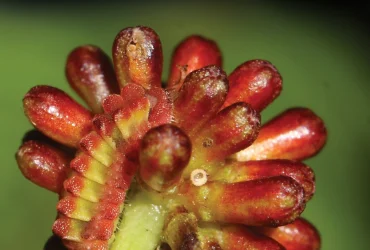 v6i2.139
v6i2.139ISSN: 1800-427X (print)
eISSN: 1800-427X (online)
DOI:10.47605/tapro.v6i2.139
Submitted date: 11 February 2014
Accepted date: 1 May 2014
Published date: 30 August 2014
Pp. 79–82.
RESURRECTING THE TYPE LOCALITY OF Ceropegia odorata (APOCYNACEAE) AFTER 175 YEARS
R. Kr. Singh*, Sameer Patil & J.S. Jalal
*Corresponding author. E-mail: rksbsiadsingh@yahoo.co.in
Abstract
The type locality of the critically endangered Ceropegia odorata Nimmo ex J. Graham is resurrected after a lapse of about 175 years. A detailed description, distribution, habitat, IUCN threat status, and a nomenclatural note are provided along with a neotype designation. The main threat factors responsible for dwindling of populations of the species are discussed and measures are suggested to arrest the operative causal factors.
Key words : Borivali NP, critically endangered, fragrant flower, Maharashtra, neotype, Salsette Island
Section Editor: James L. Reveal
eISSN: 1800-427X (online)
DOI:10.47605/tapro.v6i2.139
Submitted date: 11 February 2014
Accepted date: 1 May 2014
Published date: 30 August 2014
Pp. 79–82.
RESURRECTING THE TYPE LOCALITY OF Ceropegia odorata (APOCYNACEAE) AFTER 175 YEARS
R. Kr. Singh*, Sameer Patil & J.S. Jalal
*Corresponding author. E-mail: rksbsiadsingh@yahoo.co.in
Abstract
The type locality of the critically endangered Ceropegia odorata Nimmo ex J. Graham is resurrected after a lapse of about 175 years. A detailed description, distribution, habitat, IUCN threat status, and a nomenclatural note are provided along with a neotype designation. The main threat factors responsible for dwindling of populations of the species are discussed and measures are suggested to arrest the operative causal factors.
Key words : Borivali NP, critically endangered, fragrant flower, Maharashtra, neotype, Salsette Island
Section Editor: James L. Reveal
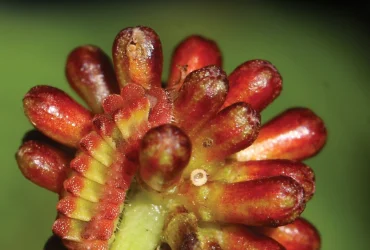 v6i2.138
v6i2.138ISSN: 1800-427X (print)
eISSN: 1800-427X (online)
DOI:10.47605/tapro.v6i2.138
Submitted date: 11 December 2013
Accepted date: 17 January 2014
Published date: 30 August 2014
Pp. 76–78, Pl. 3.
Mitracarpus hirtus VAR. sessilis VAR. NOV. (RUBIACEAE) FROM INDIA
Tandyekkal Dhruvan*, A. G. Pandurangan & N. Mohanan
*Corresponding author. E-mail: tdhruvan@gmail.com
Abstract
A new variety of Mitracarpus hirtus (L.) DC. is described and illustrated. It forms the second new taxon of the genus from the Old World. Mitracarpus hirtus (L.) DC. var. sessilis Dhruvan, Pandur., and Mohanan var. nov. differs from Mitracarpus hirtus (L.) DC. var. hirtus by its sessile, broader, denser flowers in larger glomerules, two larger, oblong or oblong-elliptic, calycine calyx lobes with a mucronate apex, two shorter, linear-lanceolate, hyaline calyx lobes, capsules with S-shaped bent calyx lobes that lack aristate tip, and by grayish-brown seeds.
Key words : Introduced plants, invasive species, new variety, Old World, taxonomy, Western Ghats
Section Editor: James L. Reveal
eISSN: 1800-427X (online)
DOI:10.47605/tapro.v6i2.138
Submitted date: 11 December 2013
Accepted date: 17 January 2014
Published date: 30 August 2014
Pp. 76–78, Pl. 3.
Mitracarpus hirtus VAR. sessilis VAR. NOV. (RUBIACEAE) FROM INDIA
Tandyekkal Dhruvan*, A. G. Pandurangan & N. Mohanan
*Corresponding author. E-mail: tdhruvan@gmail.com
Abstract
A new variety of Mitracarpus hirtus (L.) DC. is described and illustrated. It forms the second new taxon of the genus from the Old World. Mitracarpus hirtus (L.) DC. var. sessilis Dhruvan, Pandur., and Mohanan var. nov. differs from Mitracarpus hirtus (L.) DC. var. hirtus by its sessile, broader, denser flowers in larger glomerules, two larger, oblong or oblong-elliptic, calycine calyx lobes with a mucronate apex, two shorter, linear-lanceolate, hyaline calyx lobes, capsules with S-shaped bent calyx lobes that lack aristate tip, and by grayish-brown seeds.
Key words : Introduced plants, invasive species, new variety, Old World, taxonomy, Western Ghats
Section Editor: James L. Reveal
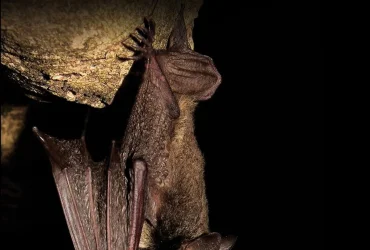 v6i1.136
v6i1.136ISSN: 1800-427X (print)
eISSN: 1800-427X (online)
DOI:10.47605/tapro.v6i1.136
Submitted date: 18 November 2013
Accepted date: 1 May 2014
Published date: 29 June 2014
Pp. 68–71, Pl. 16.
A breeding colony of the brown bat (Myotis hasseltii) from Sri Lanka
S.M. Wellappulli-Arachchi, W.G.M. Edirisinghe*, D.S.B. Dissanayake, Y. Mapatuna & S. Wickramasinghe
*Corresponding author. E-mail: gayan.yza@gmail.com
Myotis hasseltii (Temminck, 1840) variously known as the brown bat, Van Hasselt’s bat, Van Hasselt’s mouse-eared bat, or lesser large-footed myotis in the vernacular is a patchily distributed species; aside from Sri Lanka, within the Indian Subcontinent it is found only in West Bengal. The brown bat is thought to be uncommon and is a resident of land below the 1000m contour. It has been reported to roost alone or in small groups in bamboo clumps, cracks in tree bark, and in abandoned buildings. Mangrove swamps are another possible habitat for these bats. M. hasseltii likes living near water and flies low over streams, tanks (reservoirs), and mangrove swamps hunting for gnats, small flies, and mosquitoes. Extralimitally, an individual of this species was found with fish remains in its stomach.
Section Editor: Asoka Yapa
eISSN: 1800-427X (online)
DOI:10.47605/tapro.v6i1.136
Submitted date: 18 November 2013
Accepted date: 1 May 2014
Published date: 29 June 2014
Pp. 68–71, Pl. 16.
A breeding colony of the brown bat (Myotis hasseltii) from Sri Lanka
S.M. Wellappulli-Arachchi, W.G.M. Edirisinghe*, D.S.B. Dissanayake, Y. Mapatuna & S. Wickramasinghe
*Corresponding author. E-mail: gayan.yza@gmail.com
Myotis hasseltii (Temminck, 1840) variously known as the brown bat, Van Hasselt’s bat, Van Hasselt’s mouse-eared bat, or lesser large-footed myotis in the vernacular is a patchily distributed species; aside from Sri Lanka, within the Indian Subcontinent it is found only in West Bengal. The brown bat is thought to be uncommon and is a resident of land below the 1000m contour. It has been reported to roost alone or in small groups in bamboo clumps, cracks in tree bark, and in abandoned buildings. Mangrove swamps are another possible habitat for these bats. M. hasseltii likes living near water and flies low over streams, tanks (reservoirs), and mangrove swamps hunting for gnats, small flies, and mosquitoes. Extralimitally, an individual of this species was found with fish remains in its stomach.
Section Editor: Asoka Yapa
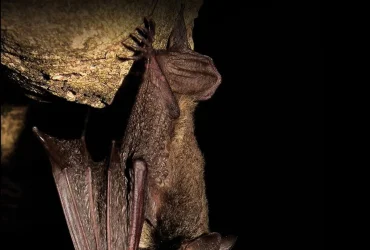 v6i1.135
v6i1.135ISSN: 1800-427X (print)
eISSN: 1800-427X (online)
DOI:10.47605/tapro.v6i1.135
Submitted date: 30 September 2013
Accepted date: 23 April 2014
Published date: 29 June 2014
Pp. 66–67.
On the nectar feeding by the fulvous fruit bat (Rousettus leschenaulti)
W.G.M. Edirisinghe* & T.G.T. Kusuminda
*Corresponding author. E-mail: gayan.yza@gmail.com
Phytophagous or fruit bats feed primarily on fruits, seeds, and flower buds. Some fruit bats also feed on flower nectar, a habit that affects pollination and plant dispersal. As a consequence of chiropteran nectarivory many commercially important plant species are known to be pollinated. Nectar is an important source of carbohydrates and water for bats. Plant characteristics that influence pollination include time of anthesis; mode of nectar secretion; the colour, odour, morphology, position of flowers; the amount and protein content of pollen; the volume of nectar; and, the concentration of sugar.
Section Editor: Asoka Yapa
eISSN: 1800-427X (online)
DOI:10.47605/tapro.v6i1.135
Submitted date: 30 September 2013
Accepted date: 23 April 2014
Published date: 29 June 2014
Pp. 66–67.
On the nectar feeding by the fulvous fruit bat (Rousettus leschenaulti)
W.G.M. Edirisinghe* & T.G.T. Kusuminda
*Corresponding author. E-mail: gayan.yza@gmail.com
Phytophagous or fruit bats feed primarily on fruits, seeds, and flower buds. Some fruit bats also feed on flower nectar, a habit that affects pollination and plant dispersal. As a consequence of chiropteran nectarivory many commercially important plant species are known to be pollinated. Nectar is an important source of carbohydrates and water for bats. Plant characteristics that influence pollination include time of anthesis; mode of nectar secretion; the colour, odour, morphology, position of flowers; the amount and protein content of pollen; the volume of nectar; and, the concentration of sugar.
Section Editor: Asoka Yapa
Hubungi Kami
The ultimate aim of the journal is to provide an effective medium for communication of the latest and best scientific information.
Copyright © 2020 Taprobanica. All Rights Reserved
Jasa Pembuatan Website by IKT




